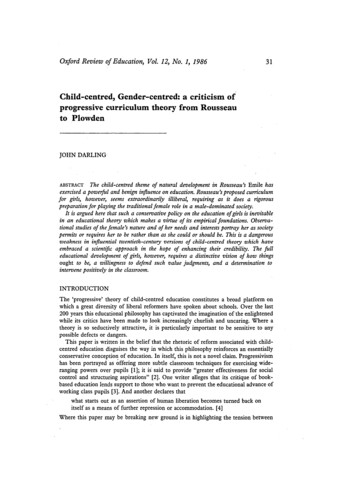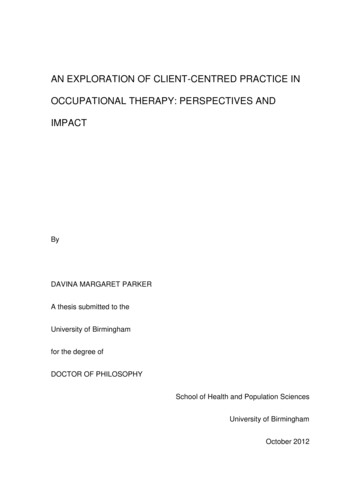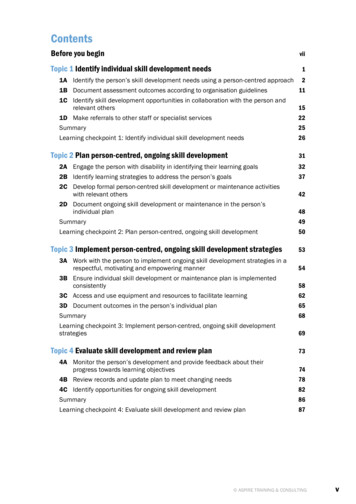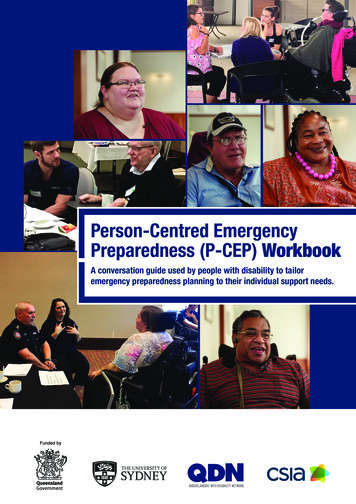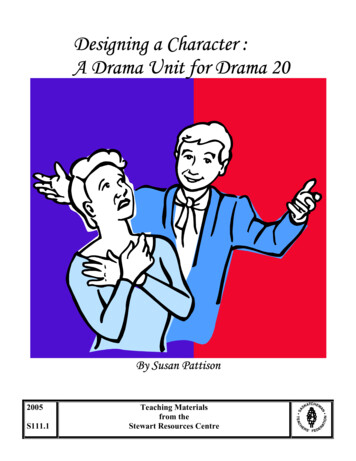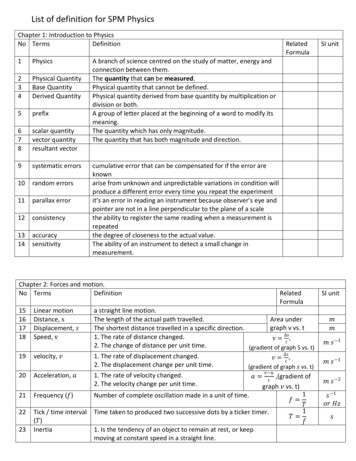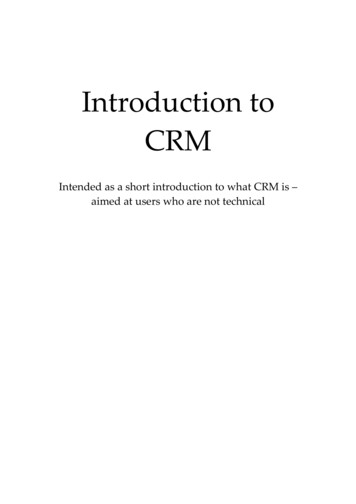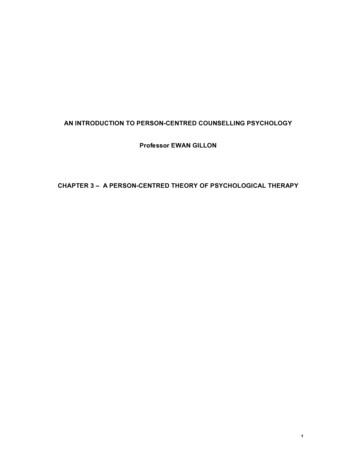
Transcription
AN INTRODUCTION TO PERSON-CENTRED COUNSELLING PSYCHOLOGYProfessor EWAN GILLONCHAPTER 3 – A PERSON-CENTRED THEORY OF PSYCHOLOGICAL THERAPY1
IntroductionAs we saw in the previous chapter, Rogers’ (1959) theory of personality positedincongruence between organismic experiencing and the self-concept as the sole causeof all psychological disturbance. Following on from such a view, it is the reduction ofincongruence that is associated with greater psychological wellbeing and, as such,provides the rationale for a person-centred approach to psychological therapy. In thischapter we shall explore the person-centred therapeutic approach, highlighting how itworks to reduce incongruence in the ways initially described by Rogers (1957), as wellas those subsequently developed by others within the framework (e.g. ‘experiential’practitioners)A theory of therapySince first outlining his ideas for psychotherapy in the early 1940s, Carl Rogersconsistently highlighted the role of the relationship between client and counsellor as ofprimary significance in therapeutic practice. This was a stance that evolved from his ownexperiences of working as a psychologist, and informed by his awareness of a widerange of other psychological theories and approaches. Rogers saw an effectivetherapeutic relationship as denoted by the presence of a systematic series ofcounsellor attitudes in conjunction with certain factors primarily linked to the client. Ifeach of these dimensions were in place, he argued it was inevitable that psychologicalgrowth would occur.In 1957 he published a paper entitled The Necessary and Sufficient Conditions ofTherapeutic Personality Change in which he detailed six conditions which were‘necessary and sufficient’ for psychological change to occur within a client. Rogersdeliberately used the word sufficient to make it absolutely clear that these conditions, ifmet, were enough to produce change. Nothing else was needed. Indeed, he sawfurther techniques or methods drawing on the expertise of the therapist (such as advicegiving or interpretations) as an irrelevant sideshow.This paper is now known as his integrative statement (Wilkins, 2003) because it wasdesigned to be relevant to all psychotherapy and drew on research and analysis from a2
range of psychological approaches, not simply person-centred therapy. Hence, Rogers’(1957) proposition was that any relationship possessing the conditions he specifiedwould produce psychological change within the client, irrespective of whicheverpsychological approach was employed. For him, psychoanalytic and behaviouristapproaches would thus be equally effective if the relationship between client andtherapist in these contexts possessed the same qualities, and in the same measures,as those offered within a person-centred therapeutic context. What really mattered wasthe relationship a therapist had with his or her client, with psychological changeguaranteed if this relationship met the following conditions (Rogers, 1957):1.Two persons are in psychological contact.2.The first, whom we shall term the client, is in a state of incongruence, beingvulnerable or anxious.3.The second person, whom we shall term the therapist, is congruent orintegrated in the relationship.4.The therapist experiences unconditional positive regard for the client.5.The therapist experiences an empathic understanding of the client’s internalframe of reference and endeavours to communicate this experience to theclient.6.The communication to the client of the therapists empathic understandingand unconditional positive regard is to a minimal degree achieved.Although there is some discussion over the precise terminology of the conditions asstated (c.f. Embleton-Tudor et al. 2005), the emphasis on relationship is clear. Ingeneral, the 6 conditions are considered as to have two basic components, thoseassociated with the actions and experiences of the therapist (conditions 3, 4 and 5), andthose linked to the client’s experiences and capacity to engage in a therapeuticrelationship. Conditions 3, 4 and 5, the so-called ‘therapist conditions’ (Barratt-Lennard,1998) are often termed the core conditions, and are those most often referred to withinother therapeutic orientations (e.g. Egan, 1998) as well as providing the focus for muchresearch and analysis (e.g. Norcross, 2002). They are seen as core because theyconcern the conduct the therapy itself and are thus often seen as the vehicle throughwhich change is enabled. Each is seen to play a different, but equally important, part infacilitating a client to become more congruent.3
The ‘core’ conditionsThe three core conditions, empathy, unconditional positive regard and congruence,present a considerable challenge to the person-centred practitioner, for they are notformulated as skills to be acquired, but rather as personal attitudes or attributes‘experienced’ by the therapist, as well as communicated to the client for therapy to besuccessful (this latter requirement is stated in condition 6). Congruence (condition 3) issomewhat different but again seen as a quality of the therapist, rather than an action orskill. This emphasis on personal attributes served to counteract any existing notions thatperson-centred therapy is simply a mechanistic process of non-directive repetition in thepresence of warmth (as often simplistically understood). However, in placing theemphasis upon the therapist to experience particular qualities, and to communicatethese in such a way that is, at the very least, minimally achieved (condition 6), Rogershighlighted the very personal nature of the therapeutic relationship he envisaged.For Rogers, therapeutic work is an inherently personal task with its success whollydependent on the capacity of the therapist to enter into an experiential relationship witha client, not hide behind professional masks or intellectual expertise. This capacity is notacquired through formalised academic learning or by training to be a professionalpsychologist (although such knowledge is important to support such work), but throughself-development and personal growth activities, such as group and personal therapy .Indeed, he later described this capacity, once developed, as a ‘way of being’ (Rogers,1980), suggesting at times that the very ‘presence’ of another person offering thesequalities is sufficient for psychological change to occur (Rogers, 1986).Box. 1 Non-Directivity and the Therapeutic RelationshipAlthough often not stated directly, the principle of non-directivity is often seen to remainsat the heart of Rogers’ person-centred approach to therapy (e.g. Grant, 1990). It isenmeshed in the 6 conditions identified by Rogers in 1957, and in particular theconditions of therapist empathy and unconditional positive regard. In being committed tooffering these attitudes, a person-centred counsellor does not attempt to take control ofa client’s experiencing by diagnosing particular psychological disorders or by instructinga client how best to deal with the problems he or she encounters. Instead, the client isviewed as the expert on his or her own life, and accordingly supported to exerciseautonomy in making choices (Merry, 1999), As a result of this non-directive approach,the client is enabled to grow in accordance with his or her unique attributes, and fully4
trusted in this process. A commitment to non-directivity represents, at its most basic, afundamental person-centred belief in the client’s actualising tendency, or in other wordsher capacity to function as an autonomous, constructive and self-regarding being.The notion of non-directivity is a highly controversial aspect of person-centred theory,with critics such as Kahn, (1999) arguing that it renders a therapist passive in the faceof all client desires or intents, as well as denying the inevitable impact of the counsellorsown views and ideas on the counselling process itself. However, Mearns and Thorne(2000) propose that the whole question over non-directivity is misplaced, for like in the1940’s, the idea is often misinterpreted as a behaviour rather than an attitude orprinciple. Instead it is better seen, as Merry (1999) suggests as “ a general nonauthoritarian attitude.it refers also to the theory that the actualising tendency can befostered in a relationship of particular qualities, and that whilst the general direction ofthat tendency is regarded as constructive and creative, its particular characteristics inany one person cannot be predicted, and should not be controlled or directed” (p.75-76).EmpathyEmpathy is perhaps the most well-known of Rogers’ therapeutic conditions, and iscertainly the one which attracted the most attention at the early stages of the approach(Raskin, 1948: Patterson, 2000). The key characteristic of empathy is understandinganother persons subjective reality as she experiences it at any given moment. Thisrequires an orientation toward the clients’ ‘frame of reference’, a phenomenological termused to describe the particular issues, concerns and values that are relevant to thatindividual in that moment. It is thus an attitude through which the therapist strives to“enter the client’s private perceptual world and [become] thoroughly at home within in”(Rogers, 1980, p142). In other words, empathy is the experience of trying to fullyunderstand another person’s world.In contrast to sympathy, which involves a sharing of outlook or experience, empathyrequires a ‘bracketing’ (Cooper, 2004) or setting aside, by the practitioner, of ownexperiences, attitudes and ideas, with a focus, instead, on trying to understand howanother person is feeling and thinking. From a therapists’ point of view, an empathicattitude is a desire to understand a clients perceptual world as if it was his or her own(Rogers, 1959). The term ‘as if’ is important here, for it denotes that empathy is aboutdeeply understanding a client’s experiences while at the same time not forgetting thatthey reside within the client (Macmillan, 1997). This recognition allows a counsellor tomaintain the separation between his or her own experiences and those of another5
(Tolan, 2003), something which is of paramount importance to avoid confusion andmisunderstanding.Being empathicThe most common method of experiencing empathy is to listen to closely to what a clientis saying, not only though words, but also through all forms of non-verbal and bodilycommunication. For Brodley (2000, pp.18) the targets of empathic understanding arethus a “clients perceptions, reactions, and feelings, and the ways in which the client as aself or person is an agency, an actor, and active force – a source of actions andreactions”.Empathic understanding is only effective in person-centred terms if is effectivelycommunicated (condition 6) to a client, a process that ensures the client knows that thetherapist understands how he feels as well as checks the extent to which the empathyexpressed is accurate. There are a number of common mechanisms employed withinperson-centred therapy to achieve this. Perhaps the most familiar of these is reflectingback, or paraphrasing, a client’s personal experiencing (which can include, thoughts,feelings and, indeed, motivations for future actions; Bohart, 1997). In order to ensureaccuracy, however, any kind of empathic statement has within it the implied question ‘isthis how it is for you?’ (Barratt-Lennard, 1998). Indeed, Rogers steered away from theuse of the term ‘reflection’ in relation to empathy, preferring instead phrases such‘testing understandings’ or ‘checking perceptions’. These he argued, were moreaccurate descriptions of what was actually occurring in the moment by moment trackingof a client’s frame of reference at any given moment (Rogers, 1986).Box 2. Example of empathic reflectionC:I have been having a dreadful time recently, what with all the disruption at homeand work. It just seems as if things couldn’t get much worse.T:So, it’s been a terrible both at home and at work. It seems to be coming at youfrom all sides. Things couldn’t get any more awful than they are at the moment?C:Yes, I’m at my wits end (becoming tearful)In this example, the client (C) describes a view of her situation, indicating that her recent“dreadful” time is linked to “disruption” at home and at work. Rather that ask for moredetails as to the nature of the disruption cited, or why it has had such an effect (as,perhaps, may be expected in normal conversation), the therapist (T) offers an empathic6
reflection of the clients experiences. This allows the client to experience the therapist’sunderstanding of her feelings (“I’m at my wits end”), a process which deepens theextent to which she contacts her organismic experiencing (i.e. the feelings that invoketearfulness).Despite the emphasis on reflection. Bozarth (1984) has suggested the attitudinal basis ofempathy within the person-centred framework allows for a far greater range of empathicresponses than often acknowledged. He argues that the person-centred therapist shouldactively strive to develop what he terms as idiosyncratic modes of empathy which are(op.cit, pp.75); “not standardised responses but idiosyncratic to the persons andinteractions between the persons in therapy sessions. Such modes are learned bytherapists as they are allowed to affirm their personal power as therapists.the equatingof reflection with empathy has restricted the potency of therapists. The focus on empathyas a verbal clarification technique limits the intuitive functions of therapists”In suggesting the empathic attitude is idiosyncratic, Bozarth makes it clear that therapistsmust learn to use their intuitive experiencing as part of the empathy process, and henceemploy methods such as metaphors, similes, questions, silences and personalreflections to relate their understanding to the client. Such methods, which often may beexperienced as risky for they do not offer a certain outcome (Bozarth, 2004), can evoke(Rice, 1974) an aspect of organismic experiencing not previously acknowledged.Indeed, for Cooper (2002) empathy is not simply a cognitive or affective process butalso a bodily one involving physical sensations (such as feelings of nausea). Bodilysensations, when experienced by a therapist, may empathically resonate with a clientsown bodily experiencing at a particular moment in time, thus providing an importantvehicle for empathic understanding. Forms of physical posture and gesture that mimic,intentionally or otherwise, a client’s bodily presentation may also be considered asinherent elements of a truly empathic relationship. Indeed, Cooper argues that there ismuch evidence to indicate such a mimetic process is, what he terms “an innate andinstinctive human capability” (pp. 224). For the therapist, therefore, the issue is less ofhow to develop embodied methods of empathising and more as to how can such naturalforms of relating be (op.cit., pp.224) “allowed to emerge” in the context of a therapeuticprocess.7
The role of empathy in facilitating changeWhen situated within a person-centred therapeutic relationship, empathy is seen bysome to play a curative role (Warner, 1996) in facilitating psychological growth. ForRogers (1959), this role links primarily to the act of clarifying and checking (i.e. reflectingback), a process which encourages a client to enter more deeply into his or her personalexperiencing. As the therapist attempts to understand the client’s inner world, herempathic responses serve to assist the client to contact (Warner, 1996) organismicvalues, for example, to clarify the extent to which the therapist’s description maps ontoan aspect of organismic experiencing previously denied or distorted. As a result of thisprocess, the client moves deeper into what is felt at an organismic level, perhaps for thefirst time recognising or conceptualising a particular experience (e.g. fear) that was notpreviously acknowledged within the self (i.e. something that I, as a person, feel). Indoing this, she is potentially able to integrate these new felt experiences into her view ofwho she is (i.e. her self-concept). This process relieves the tension or anxiety producedby the incongruence between self and organismic experience, thus facilitatingpsychological change.Over the years, many theorists have attempted to explicate in greater detail the role andnature of empathy as part of the therapeutic endeavour (Wilkins, 2003). Vanerschot(1993) has attempted to draw together a number of strands of such work in proposing aframework for understanding how empathy works to produce a number of microprocesses in the client. For Vanerschot, empathy works in three ways. Firstly, anempathic climate created by a therapist serves to foster self-acceptance and trust by theclient through the experience of being understood and accepted by another. This worksto counteract her lack of positive self-regard. Secondly, as discussed previously, theconcrete empathic responses (e.g. reflecting a feeling) made by a therapist serve toenhance and facilitate a client’s experiencing, by assisting her to move further into hisorganismic experiencing. Such responses may relate to aspects of a client’s experiencethat are at the very edge (Gendlin, 1981) of her conscious awareness (i.e. poorly deniedor distorted) and hence involve the therapist using responses such as exploratoryquestions (e.g. “I wonder if there is something else other than anger in how you feel atthe moment”), empathic guesses (” I guess you must feel pretty sad that she has left8
you”) and experiential responses (e.g. “ I don’t know why but I feel very tearful when youspeak about your father”). Such responses are often termed ‘deep’ or ‘advanced’empathy (Mearns and Thorne, 1988) to denote the way that they relate to an aspect ofthe client’s experiencing that is not directly being addressed or acknowledged until thatpoint.Finally, all empathic responses to a client have a cognitive effect, assisting the client toalso re-organise the meanings of the experiences being processed. This is the thirdelement identified by Vanershot (1983), and is a product of assisting the client to focushis or her attention on particular experiences, to recall information relating to anexperience or to organise information in a more differentiated and elaborative manner.From such a perspective, the therapist may be seen as, what Wexler (1974) suggests asa ‘surrogate information processor’, whose empathic responses facilitate a process ofcognitive re-organisation and re-structuring.Unconditional positive regardAlthough empathy is seen by many as the primary, change-related dimension of personcentred therapy, unconditional positive regard has also been proposed by some (e.g.Bozarth, 1998, Wilkins, 2000) as the fundamental element of the relationship specifiedby Rogers (1957). In contrast to the long history enjoyed by empathy as part of Rogers’approach, the concept of unconditional positive regard did not emerge until the mid-late1950’s, having previously been referred to as acceptance, warmth, prizing and respect(Bozath, 2002). Indeed, the terms are still often used interchangeably, although forsome (e.g. Purton, 1998) the differences in meaning between them introduces aconceptual confusion regarding what each actually involves.For the majority of person-centred practitioners, unconditional positive regard, along withthe various terms equated with it, simply refers to the experiencing and offering of aconsistently accepting, non-judgemental and valuing attitude toward a client (Lietaer,1984). For Brazier (1993) this may best be considered as a form of non-possessive‘love’, a warm acceptance the client as he is in any given moment, not judging,instructing or neglecting. The term ‘unconditional’ is thus used to denote this quality –nothing is required of a client for her to be viewed in a positively regarding manner.9
Offering unconditional positive regardUnconditional positive regard is perhaps the most challenging of all the conditions toexperience and thus to offer. Indeed, in discussing how to accomplish this, the majorityof training materials (e.g. Tolan, 2003) concentrate on what it is not unconditionalpositive regard, rather than what it is! Despite this, offering unconditional positive regardoften relies on listening and responding non-judgementally to whatever a client isexperiencing at a given moment. Although this may imply a passive quality,unconditional positive regard is more active, openly warm, valuing process. Indeed,Freier (2001) argues that the term positive is used deliberately to indicate the warmnature of the experience, rather than a cold form of passive acceptance indicating‘neutral passivity’. What this means, in practice, is that in offering unconditional positiveregard, the counsellor actively strives to warmly value the client in all aspects of his orher experiencing. As Brodley and Schneider (2001, pp.156) suggest;“ Client-centred therapists consciously cultivate a capacity for unconditional acceptancetowards clients regardless of the client’s values, desires and behaviours. The UPRcapacity involves the ability to maintain a warm, caring, compasionate attitude and toexperience those feelings toward a client regardless of their flaws, crimes or moraldifferences from oneself”Box 3. Is unconditional positive regard possible?The idea of unconditional positive regard has been strongly criticised by varioustheorists (e.g. Masson, 1992) who argue out that it requires a therapist to withhold anymoral judgements on another individual’s actions. This, they suggest is impossible aswell as politically unacceptable. Certain forms of behaving (e.g. violence toward others)are wrong and should not be accepted. As someone’s ‘self’ cannot be separated fromher ‘behaviour’ (Purton, 1998), it is not possible to offer unconditional positive to anindividual’s inner experiences, whilst not condoning what they do. Hence, as Seager(2003, p.401) proposes, “unconditional positive regard is impossible in any humanrelationship”.For person-centred practitioners, such a view of unconditional positive regard fails torecognise a number of important aspects regarding its place within the person-centredtherapy. Firstly, as with all the core conditions, it is not an experience that a therapist isviewed as able to have all the time when relating to a particular client. Thismisapprehension is perhaps a product of its name, which has an absolute, either orquality that does not reflect the flowing process of any relationship within which the10
conditions are upheld to different extents at different times (Rogers, 1957). Secondly, noact or experience is inherently unacceptable, and a therapists capacity to offerunconditional positive regard is a product of his social, cultural and individual values.Thus the experiencing of unconditional positive regard is linked to a therapist’s ownmoral standpoints. It is also enmeshed with the level of his own self-acceptance, for ourcapacity to unconditionally value another stems from our capacity to understand, andaccept, ourselves in all of our flaws (Mearns and Thorne, 1988). Such understandingand self-acceptance enables us to experience a client in a non-defensive manner, andhence to look behind (Wilkins, 2000) an unacceptable behaviour or attribute tounderstand the psychological suffering or pain underlying it. Of course there areoccasions in therapeutic relationships when this is not possible, for example, when aparticular client is encountered that presents a particularly powerful challenge to themoral stance we uphold. For Wilkins (2000), within such circumstances we are able torecognise our limitations, which in turn allows us to find the most appropriate way ofenabling that client to be transferred to a different therapist who, as a result of his or herown unique personality, may view the situation differently, or indeed may have thecapacity to offer a greater level of unconditional positive regard. Thus, from such astandpoint, unconditional positive regard is not impossible, but dependent upon thematch between therapist and client.The role of unconditional positive regard in facilitating therapeutic changeUnconditional positive regard works, as part of the therapeutic relationship, bydiminishing conditions of worth which are at the root of the incongruence betweenorganismic experience and the self. As conditions of worth are acquired through aconditionally valuing relationship, unconditional positive regard is seen to stimulate theexact opposite, a climate of unconditional acceptance and warmth. It is the veryunconditionality of this climate that promotes growth, for it enables the processes ofpsychological defence to be reversed. This reversal is simply a product of the degree ofthreat presented by conditions of worth being gradually eroded by the presence of anunconditionally warm and accepting other (Rogers, 1959).The role of unconditional positive regard is enmeshed with the processes of empathy. Incontacting denied or distorted organismic experiencing that is then unconditionallyaccepted and valued by a therapist who is empathically attuned, the client is able to feelfully accepted and thus develop a greater sense of positive self-regard. As Lietaersuggests (2001, p.105), unconditional positive regard thus produces “a high level ofsafety which helps unfreeze blocked areas of experience and to allow painful emotionsin a climate of holding.self-acceptance, self-empathy and self-love are fostered”. Whenthese are empathically received, the client is able to re-configure his or her self-concept11
to encompass greater levels of organismic experiencing, thus reducing the incongruenceat the root of her distress.CongruenceLike unconditional positive regard, the concept of congruence emerged in the 1950’sand was first introduced in Rogers’ personality theory (1951) to denote the state inwhich the self and organismic experiencing are aligned (i.e. the opposite ofincongruence). It was subsequently identified of relevance to therapy within Rogers(1957) theory of the necessary and sufficient conditions of therapy. Congruence, aspart of these conditions, is formulated as a state of being (Wilkins, required of thetherapist within the counselling relationship (i.e. 'the second person, whom we shall termthe therapist, is congruent or integrated in the relationship”' Rogers, 1957). By contrast,the client within such a relationship is incongruent ('the client, is in a state ofincongruence, being vulnerable or anxious', (Rogers, 1957). He thus defined congruencein therapy as meaning;“that the therapist is his actual self during his encounter with his client. Without facade,he openly has the feelings and attitudes that are flowing in him at the moment. Thisinvolves self-awareness; that is, the therapist’s feelings are available to him – to hisawareness – and he is able to live them, to experience them, in the relationship, and tocommunicate them if they persist” (Rogers, 1966, p.185).Congruence thus refers to the therapist’s capacity to be aware of the full extent of herown organismic experiencing (unlike the client who is still incongruent). Although theterm congruence was used interchangeably with other adjectives such as authentic andgenuine, Rogers regarded the requirement for the therapist to be attuned to actual selfas the most fundamental of all the three core conditions (Rogers and Sanford, 1984).He saw no role for professional façade nor the impersonal relating often associated witha lack of self-development (or incongruence) on behalf of the therapist.Being congruent12
The condition of therapist congruence is the least understood of all the core conditionsand has been open to considerable misunderstanding and misinterpretation over theyears (Wyatt, 2001). Although the meaning of congruence is not in doubt, being a statewhere a therapist is not subject to incongruence between self and organismicexperiencing, there are a number of areas of debate surrounding what this actuallyinvolves in terms of therapeutic practice. Perhaps the most controversial of these is theextent to which a therapist communicates his or her inner organismic experiencing (e.g.feelings of anger, or sadness) to her client. This controversy stems right back to the workof Rogers, who viewed the expression of genuine feelings as part and parcel of beingcongruent within a therapeutic relationship (Rogers 1959). Yet, for Lietaer (1993), atherapist’s inner awareness of her ongoing experiencing must be differentiated from theouter expression of this experiencing. For him, these are two different things, and onlywhen taken together represent the therapists genuineness (or congruence) in therelationship. From such a standpoint, the congruent practitioner must be aware of thesedifferent elements and attend to each within the therapeutic encounter.One of the key issues arising from the distinction between an awareness of organismicexperiencing (e.g. feeling sad) and the expression of such experiencing is an importantone, how each relates to the other, particularly in terms of what inner experiences todisclose, and how (e.g. Tudor and Worrall, 1994, Barratt-Lennard, 1998). It is one thingfor a therapist to recognise and acknowledge within herself a particular experience witha client (e.g. “Gosh, I feel so sad when she talks about her Mother”). It is a very differentmatter to determine when and how to express this experience to that client. Certainly, indiscussing the expression of therapists feelings and experiences in therapy with a client,Rogers (1966, p. 185) urged caution;“[congruence] does not mean that the therapist burdens his client with the overtexpression of all his feelings, Nor does it mean that the therapist discloses his total selfto the client. It does mean, however, that the therapist denies to himself none of thefeelings he is experiencing and that he is willing to experienc
AN INTRODUCTION TO PERSON-CENTRED COUNSELLING PSYCHOLOGY . Introduction As we saw in the previous chapter, Rogers’ (1959) theory of personality posited incongruence between organismic experiencing and the self-concept as the sole cause of all psychological disturban

